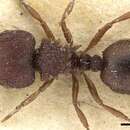en
names in breadcrumbs


Taxonomic history
Forel, 1915b PDF: 44 (m.).See also: Schödl, 2007 PDF: 387.(Figs. 34, 35, 69, 83, 95)
Meranoplus diversus F. Smith , 1867: 527, pl. 26, fig. 2 (Champion Bay [= Geraldton], Western Australia; worker), Forel, 1915: 44 (male). Taylor & Brown, 1985: 67 (catalogue), Taylor, 1987: 38 (listed), Bolton, 1995: 251 (catalogue), Shattuck, 1999: 142 (listed). Holotype worker (BML, examined), ' Smith coll. pres. by Mrs. Farren White. 99 - 303. [printed] Meranoplus diversus . Sm. Trans. Ent. Soc. [handwriten on bright violet label] Brit. Mus [handwritten on bright violet label] Holotype [round printed red circled label] '.
WORKERS (n = 10). TL 5.85 - 6.95, HL 1.50 - 1.75, HW 1.75 - 2.03, FC 1.25 - 1.45, CS 1.63 - 1.87, SL 0.8 - 0.9, SI 1 44 - 46, SI 2 46 - 50, PML 1.05 - 1.27, PW 1.37 - 1.55, PMI 118 - 133, PMD 1.50 - 1.77, PMI 2 107 - 120, ML 1.30 - 1.75, PTLL 0.40 - 0.50, PTLH 0.60 - 0.75, PTDW 0.48 - 0.64, PPLL 0.38 - 0.50, PPLH 0.48 - 0.78, PPI 63 - 79, PPDW 0.48 - 0.60, PT / PP 100 - 109.
Mandible with three teeth. Clypeus medially deeply excavated, distinctly acutely bidentate, longitudinally carinulate, sunk into prolonged anterolateral frontal projections. Head distinctly wider than long (CI 112 - 120), lateral sides almost straight, feebly narrowing anteriorly, preoccipital corners bulbously rounded, the rear margin emarginate. Frontal carinae evenly sinuately narrowed towards clypeus, distinctly narrower than head width (FI 132 - 145). Antennal scrobes in lateral view surpassing middle of length of head posteriorly, distinctly transversely carinulate in posterior half, occasionally with additional shagreening, posteriorly rather distinctly demarcated from remainder of head. Genae and ventrolateral sides of head carinate to rugose, preoccipital lobes reticulate. Compound eyes moderately large (EL 0.25 - 0.32, REL 0.17 - 0.20, with 15 - 20 ommatidia in the longest row) situated distinctly in front of middle of lateral sides of head, dorsal ocular margin not reaching ventral scrobal margin.
Promesonotum wider than long (PMI 118 - 133), somewhat flanged and broadly translucently margined, concealing lateral sides of mesosoma and propodeal declivity. Propodeal spines of medium length (PSL 0.58 - 0.78) situated above middle of length of declivity, acute and slightly arcuate when seen from above.
Petiole distinctly higher than long (PTI 66 - 73), in profile wedge-shaped with anterior face straight and unsculptured, posterior face convex, distinctly and regularly costate. Postpetiole elongately nodiform distinctly tapering towards base, with ventral medium sized tooth, rugose throughout.
First gastral tergite with dense microreticulum, basal half with additional distinct striation. Dorsum of head longitudinally costulate, additionally with rugulae and only few transverse meshes, at very rear reticulate, interspaces with microsculpture; with scattered, suberect to erect hairs. Promesonotal shield coarsely rugoreticulate, with pilosity consisting of short decumbent and longer more or less erect hairs.
Concolorous brown to fuscous, frequently with the gaster somewhat brighter.
MATERIAL EXAMINED
Western Australia : Winburn Rocks , 95 km E by N ofWarburton , 16. xi. 1977 ( J. E. Feehan ) . South Australia : 26.1 km / 26.3 km ENEMimili , 25. - 31. x. 1998 (coll. unknown) ; 1.9 km WNWMt. Lindsay , 16. - 20. x. 1996 (coll. unknown) ; 18.5 km WNWUngarinna Rockhole (coll. unknown) ; 14.2 km ESEMaryinna Hills , 14. - 18. iii. 1995 (coll. unknown) ; Womikata Bore , 21. x. 1994 (coll. unknown) ; 0.5 km WSWCheesman Peak , 25. x. 1996 (coll. unknown) (38 workers, 2 gynes in ANIC , NHMW , SAMA ) .
DISCUSSION
Distributed from the west coast to central Australia. Although a wide gap is present between the type locality (Geraldton) and most material studied herein, the species should be found throughout the arid and semi-arid zones of central and Western Australia.
M. diversus is unique by the bifurcate clypeus in combination with the flanged promesonotal shield and the costate triangular petiole.